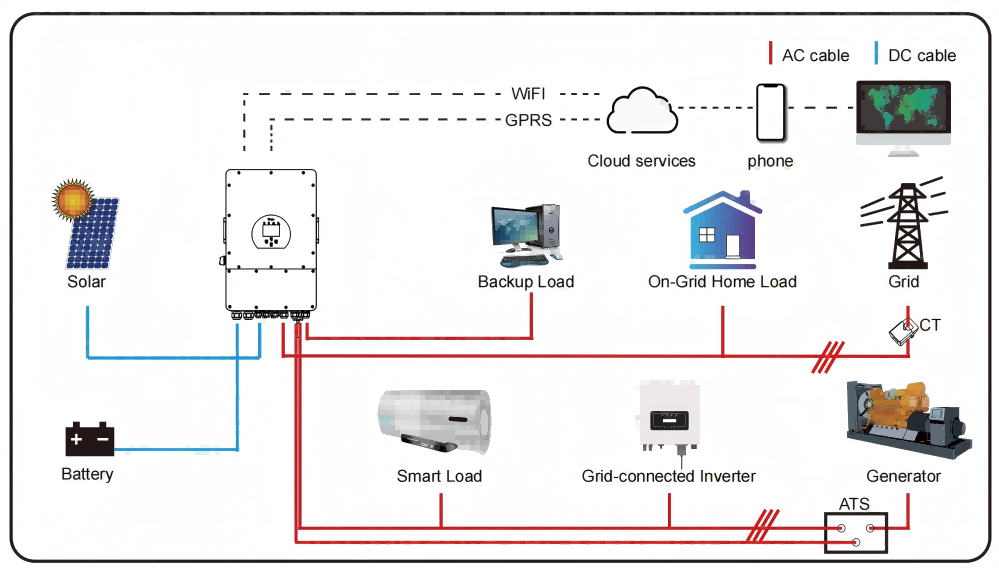Photovoltaic and off-grid energy storage systems: the future of energy use?
Driven by the transformation of the global energy structure and the goal of "dual carbon", photovoltaic power generation is being more and more widely used as a clean and renewable form of energy. However, photovoltaic power generation has problems such as intermittency and volatility, and how to use photovoltaic power efficiently has become a big challenge. Photovoltaic and off-grid energy storage system came into being, providing an effective solution to this problem.

Overview of photovoltaic and off-grid energy storage systems
Photovoltaic and off-grid energy storage system, as the name suggests, refers to the photovoltaic power generation system, energy storage system and load organic combination, both can be connected to the grid operation, can also be off-grid operation of the comprehensive energy system. Its core lies in the addition of the energy storage system, which is like a "reservoir" to store the surplus electric energy generated by photovoltaic power generation and release it when needed, so as to achieve the time-space transfer of electric energy, improve the spontaneous self-use rate of photovoltaic power generation, and reduce the dependence on the grid.
Second, photovoltaic and off-grid energy storage system composition!
A complete photovoltaic and off-grid energy storage system usually consists of the following parts:
Photovoltaic array: composed of photovoltaic modules in series and parallel, responsible for converting solar energy into direct current energy.
Energy storage battery: the core component of the system, used to store the surplus electricity generated by photovoltaic power generation. At present, the commonly used energy storage batteries include lead-acid batteries, lithium batteries, and flow batteries, which have advantages and disadvantages and need to be selected according to the specific application scenario.
Inverter: Responsible for converting direct current to alternating current to meet the load power demand. Off-grid energy storage systems usually use two-way inverters, which can realize the conversion from DC to AC, and can also realize the conversion from AC to DC to charge the energy storage battery.
Control system: the "brain" of the system, responsible for monitoring, management and scheduling of the entire system to ensure the safe, stable and efficient operation of the system.
Load: Electrical equipment, which can be household electrical equipment, industrial and commercial electrical equipment, etc.
Third, photovoltaic and off-grid energy storage system working mode
Photovoltaic and off-grid energy storage systems have three modes of operation:
Grid-connected mode: photovoltaic power generation is preferentially supplied for load use, surplus electric energy is incorporated into the grid, and when photovoltaic power generation is insufficient, it is supplemented by the grid.
Off-grid mode: The system is disconnected from the power grid, and photovoltaic power generation and energy storage batteries jointly supply power to the load.
Mixed mode: According to the actual situation, the system automatically switches between the grid-connected mode and the off-grid mode to achieve optimal operation.
Fourth, photovoltaic and off-grid energy storage system advantages!
Photovoltaic and off-grid energy storage systems have the following advantages:
Improve the self-use rate of photovoltaic power generation: the energy storage system can store the surplus electric energy generated by photovoltaic power generation and use it at night or in rainy days, reducing dependence on the grid and improving the economic efficiency of photovoltaic power generation.
Improve power supply reliability: When the power grid fails or is outage, the system can switch to the off-grid mode to continue supplying power to the load, ensuring the safety of the power consumption of important loads.
Participation in power grid peak load and valley filling: the system can charge during the low period of electricity price and discharge during the peak period of electricity price, reducing the cost of electricity and relieving the pressure of power grid peak load.
Promote renewable energy consumption: The energy storage system can smooth the output power of photovoltaic power generation, reduce the impact on the grid, and promote the consumption of renewable energy.
Photovoltaic and off-grid energy storage system application scenarios
Photovoltaic and off-grid energy storage system has a wide range of application scenarios, mainly including:
Household use: Solve the household electricity demand, reduce the electricity cost, improve the reliability of electricity.
Industrial and commercial: reduce the cost of electricity for enterprises, improve the reliability of power supply, and participate in demand side response.
Remote areas: Solve the problem of electricity in areas without electricity and improve the living conditions of local residents.
Communication base station: provides backup power for communication base station to ensure smooth communication network.
Microgrid: Build a microgrid system that operates independently to achieve energy self-sufficiency.

Fifth, photovoltaic and off-grid energy storage system development trend!
With the progress of technology and the decline of costs, photovoltaic and off-grid energy storage systems will usher in a broader space for development. The future development trend is mainly reflected in the following aspects:
Diversification of energy storage technology: In addition to lithium batteries, new energy storage technologies such as sodium-ion batteries and flow batteries will be more widely used.
System intelligence: Artificial intelligence, big data and other technologies will be applied to system control and management to achieve system operation optimization and failure prediction.
Business model innovation: New business models such as shared energy storage and cloud energy storage will continue to emerge, promoting the large-scale development of photovoltaic and off-grid energy storage systems.
Vii. Summary
Photovoltaic and off-grid energy storage system is an effective solution to solve the intermittenity and volatility of photovoltaic power generation, which has the advantages of improving the self-utilization rate of photovoltaic power generation, improving the reliability of power supply, participating in the grid peak load and valley filling, and promoting the consumption of renewable energy. With the advancement of technology and the decline of costs, photovoltaic and off-grid energy storage systems will play an increasingly important role in the future energy system, and make positive contributions to the realization of the "dual carbon" goal and the construction of a clean, low-carbon, safe and efficient energy system.

